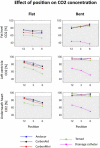Optimizing CO2 field flooding during sternotomy: In vitro confirmation of the Karolinska studies
- PMID: 38194426
- PMCID: PMC10775975
- DOI: 10.1371/journal.pone.0292669
Optimizing CO2 field flooding during sternotomy: In vitro confirmation of the Karolinska studies
Abstract
Although CO2 field-flooding was first used during cardiac surgery more than 60 years ago, its efficacy is still disputed. The invisible nature of the gas and the difficulty in determining the "safe" quantity to protect the patient are two of the main obstacles to overcome for its validation. Moreover, CO2 concentration in the chest cavity is highly sensitive to procedural aspects, such suction and hand movements. Based on our review of the existing literature, we identified four major factors that influence the intra-cavity CO2 concentration during open-heart surgery: type of delivery device (diffuser), delivery CO2 flow rate, diffuser position around the wound cavity, and its orientation inside the cavity. In this initial study, only steady state conditions were considered to establish a basic understanding on the effect of the four above-mentioned factors. Transient factors, such as suction or hand movements, will be reported separately.
Copyright: © 2024 Puthettu et al. This is an open access article distributed under the terms of the Creative Commons Attribution License, which permits unrestricted use, distribution, and reproduction in any medium, provided the original author and source are credited.
Conflict of interest statement
The authors have declared that no competing interests exist.
Figures







References
-
- De Carlo M, Liga R, Migaleddu G, Scatturin M, Spaccarotella C, Fiorina C, et al. Evolution, Predictors, and Neurocognitive Effects of Silent Cerebral Embolism During Transcatheter Aortic Valve Replacement. JACC Cardiovasc Interv. 2020; 13(11):1291–1300. doi: 10.1016/j.jcin.2020.03.004 - DOI - PubMed
Publication types
MeSH terms
Substances
LinkOut - more resources
Full Text Sources

